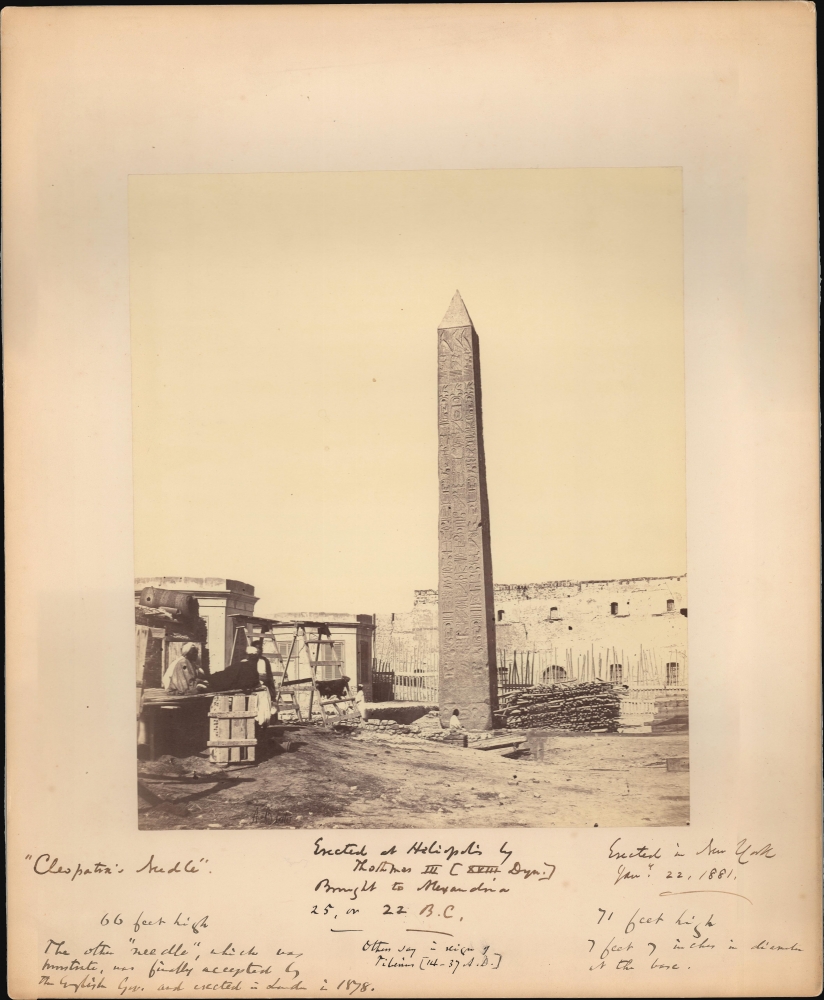1860 Antonio Beato Albumen Silver Print Photograph: Cleopatra's Needle, Alexandria
CleopatrasNeedle-beato-1860
Title
1860 (undated) 14 x 17 in (35.56 x 43.18 cm)
Description
New York Cleopatra's Needle
The New York Cleopatra's Needle, a red granite Egyptian obelisk originally erected in Heliopolis around 1450 BC by Pharaoh Thutmose III and later inscribed by Ramses II, today stands in Central Park. Gifted to the United States by the Khedive of Egypt, Isma'il Pasha, in 1877 as a diplomatic gesture, it journeyed to New York in 1880 and was erected in 1881, a testament to ancient engineering prowess. Approximately 69 feet tall and weighing around 200 tons, its hieroglyphic inscriptions celebrate the pharaohs' military triumphs and divine status. Today, it faces preservation challenges due to weathering and pollution. It is one of three obelisks referred to as 'Cleopatra's Needle', the others being in London and Paris.Provenance
These images were from the collections of Roswell Dwight Hitchcock (1817 - 1887). Hitchcock was a congregationalist minister and professor at Bowdoin and later at the Union Theological Seminary in New York. His ministry took him to Germany in the 1840s. Afterwards, he visited Italy and Greece in 1866; and in 1869 and 1870 he traveled to Egypt and Palestine. He was appointed president of the American Palestine Exploration Society in 1871, and vice-president of the American Geographical Society in 1880. Whether he acquired these before traveling to Egypt, there, or on his way back to America, is unknown.Publication History and Census
Scarce. While Beato took several photos of Cleopatra's Needle, this is the only example of the present image we have identified.Cartographer
Antonio Beato (1835 - 1906) was an Italian-British photographer best known for his work in Egypt and the Mediterranean region. Beato was born of a Venetian family. He became a British citizen as a young man. He is often associated with his older brother Felice Beato (1832 - January 29, 1909), also a photographer, with whom he worked extensively, often sharing a signature as 'Felice Antonio Beato' or 'Felice A. Beato'. The brothers may have been introduced to photography in Malta in 1850 where they met British photographer James Robertson (1813 - 1888). One of the brothers, it is not clear which, purchased photographic equipment in Paris in 1851. Again, one of the brothers accompanied Robertson to Constantinople in 1851, where they formed a partnership, 'Robertson and Beato' in 1853. By this time, both brothers were working with Robertson in Constantinople. They traveled to India, in 1857 and 1858, photographing the Indian Rebellion of 1857. Antonio set off for Europe in 1859 by way of Suez. He likely changed his plans in route, as shortly thereafter we find him in Cairo, then Luxor, where he opened a photographic studio in 1862. He remained in Luxor, taking photographs of monuments and tourists, until his death in 1906. More by this mapmaker...

